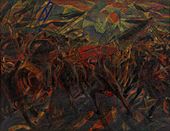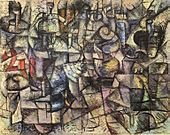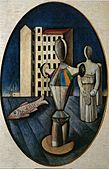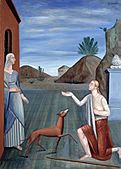Carlo Carrà facts for kids
Quick facts for kids
Carlo Carrà
|
|
|---|---|
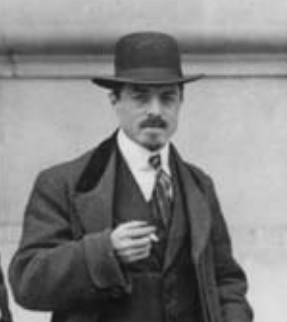
Carrà in front of Le Figaro, Paris, February 9, 1912
|
|
| Born | February 11, 1881 Quargnento, Italy
|
| Died | April 13, 1966 (aged 85) |
| Known for | Painting |
| Movement | Futurism, Metaphysical art |
Carlo Carrà (born February 11, 1881 – died April 13, 1966) was a famous Italian painter. He was a main leader of the Futurist art movement. This movement was very popular in Italy in the early 1900s. Besides his many paintings, he also wrote several books about art. He taught art for many years in the city of Milan.
About Carlo Carrà
Carrà was born in Quargnento, a town near Alessandria in Piedmont, Italy. When he was just 12 years old, he left home to work as a mural decorator. This meant he painted large pictures on walls.
In 1899 and 1900, Carrà was in Paris. He helped decorate buildings for a big event called the Exposition Universelle (a world fair). There, he learned about new French art styles. After that, he spent a few months in London. He met Italian anarchists there. Anarchists are people who believe that society should not have a government or rulers. He returned to Milan in 1901.
In 1906, he started studying at the Brera Academy art school in Milan. He learned from a teacher named Cesare Tallone. In 1910, he signed a special paper called the Manifesto of Futurist Painters. He signed it along with other artists like Umberto Boccioni, Luigi Russolo, and Giacomo Balla. This was the start of his most famous and important painting style.
Carrà's Futurist painting style changed when World War I began. His new art still used some Futurist ideas. But it started to focus more on clear shapes and quiet scenes. It was less about movement and strong feelings. He got ideas from old Italian paintings (from the 1300s), children's drawings, and the artist Henri Rousseau. Carrà soon started painting still lifes. These were pictures of everyday objects. He painted them in a simple way that showed how real they were.
In 1917, he met Giorgio de Chirico in Ferrara. They worked together for several weeks. De Chirico influenced Carrà. Carrà began to put mannequins (like store display dummies) in his paintings. These two artists created a new style they called "metaphysical painting".
By 1919, Carrà's metaphysical style changed again. He started to paint in an older style, like the artist Giotto. He admired Giotto because he felt his art showed bodies in space very well. Carrà's painting The Daughters of Lot (1919) shows this new direction in his work. He also wrote for a magazine called La Ronda between 1919 and 1922.
During the 1920s and 1930s, he mostly painted landscapes. He developed a style that showed the atmosphere of a place. An example is his 1928 painting Morning by the Sea.
Carrà is most famous for his 1911 Futurist painting, The Funeral of the Anarchist Galli. When he was young, Carrà believed in anarchism. But like many other Futurists, he later changed his political views. He became a strong supporter of his country, Italy. He also supported fascism after 1918. Fascism was a political movement that believed in a very strong government and national pride. In the 1930s, Carrà signed a paper that asked artists to support the government's ideas through their art. He joined a group called Strapaese. This group was influenced by fascism. They followed the art rules set by the government, but they did not like the idea of a very strong centralized government.
Carlo Carrà died in Milan in 1966.
Selected works
- The Funeral of the Anarchist Galli (1911)
- The Enchanted Chamber (1917)
- The Metaphysical Muse (1917)
- The Daughter of the West (1919)
- The Engineer's Lover (1921)
- Canale a Venezia (1926)
-
1911, The Funeral of the Anarchist Galli, oil on canvas, 198.7 x 259.1 cm, Museum of Modern Art, New York
-
1911, Rhythms of Objects (Ritmi d'oggetti), oil on canvas, 53 x 67 cm, Pinacoteca di Brera
See also
 In Spanish: Carlo Carrà para niños
In Spanish: Carlo Carrà para niños



